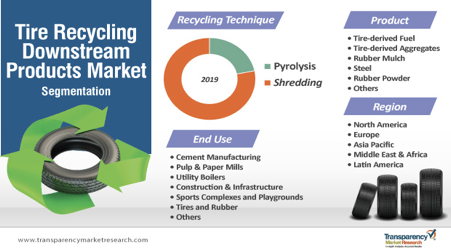The process involves turning waste or discarded end-of-life tires and tubes to usable material, which can be applied in a number of industries. One of the biggest factors leading to growth in the market includes technological advancement and a need to create a sustainable future for the tire industry. Besides, it is worth pointing out here that sustainable alternative to certain raw materials are being looked for in a number of industries.
Rubber recycling is the technique of transforming end-of-life tires and tubes into products that can be used for various applications. Novel innovations in the tire recycling downstream products market are anticipated to lead to promising results and a sustainable future for the tire industry.Likewise, crumbed rubber concrete (CRC) is expected to have increased applications in the construction industry. The mixing of crumbed rubber with concrete, instead of sand, serves as an environment-friendly alternative by keeping its material properties intact. As such, engineers are using crumbed rubber concrete to construct residential buildings, roads, and other infrastructural projects.
Since extracting natural sand from the ground creates environmental stress on resources, stakeholders in the tire recycling downstream products market are adopting crumbed rubber that can be shredded into small particles from end-of-life tires, and be formed similar to the consistency of sand. Also, crumbed rubber concrete has high tensile strength as compared to traditional concrete.
Recycling tires into materials such as rubber powder and steel-free crumb powder can lead market players in the tire recycling downstream products market towards profitable ventures. Market players in developed economies are shifting focus from raw materials to the production of high-priced consumer goods and innovative rubber products.
Manufacturers in the tire recycling downstream products market are producing waste bins that are assembled with recycled rubber wheels and chassis. These sustainable waste bins are being increasingly used in municipal corporations and business organizations in developed countries. Such sustainable innovations are not only helping manufacturers in the tire recycling downstream products market to establish themselves as environmental-friendly organizations, but also helps reduce production costs. Thus, reduction in production cost also helps stakeholders lower the price tag of sustainably produced consumer goods, consecutively initiating faster sales.
Other applications of recycled rubber in the tire recycling downstream products landscape include the production of security products such as hostile vehicle mitigation (HVM) barriers. The production of security products relies on recycled tire rubber that is blended with polyurethane for increasing the strength of HVM barriers used to raise mobile perimeters and security fence systems on roads and in stadiums.
Currently, the growing issue of the disposal and accumulation of huge volumes of end-of-life and worn-out tires poses a serious problem. As such, stakeholders in the tire recycling downstream products market are challenged with speeding up the process of recycling scrap tires and preventing scrap tires from ending up in stockpile spaces. Stockpile spaces also pose as a risk for tire fires, as burning tires cannot be easily extinguished and release hazardous toxic substances into the environment.











